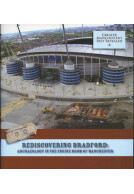The Maryport Roman Settlement Project (Paperback)
Excavation 2013-14
Imprint: Oxford Archaeology North
Series: Lancaster Imprints
Pages: 188
Illustrations: 128 colour images
ISBN: 9781907686337
Published: 18th July 2019
Script Academic & Professional
Series: Lancaster Imprints
Pages: 188
Illustrations: 128 colour images
ISBN: 9781907686337
Published: 18th July 2019
Script Academic & Professional
You'll be £25.00 closer to your next £10.00 credit when you purchase The Maryport Roman Settlement Project. What's this?
+£4.99 UK Delivery or free UK delivery if order is over £40
(click here for international delivery rates)
Order within the next 1 hour, 23 minutes to get your order processed the next working day!
Need a currency converter? Check XE.com for live rates
(click here for international delivery rates)
Order within the next 1 hour, 23 minutes to get your order processed the next working day!
Need a currency converter? Check XE.com for live rates
A research and community-training excavation took place over two summer seasons in 2013-14 within the Roman extramural settlement at Maryport, including the backplot. The primary aim of the project, which attracted around 125 volunteers, was to enhance understanding of the settlement through the excavation of a single building plot, the first time this had been undertaken at Maryport in modern times. Using geophysical survey evidence, a plot located 150 m north-east of the fort, adjacent to the main Roman road, was selected for investigation. The earliest feature was a small ditch, possibly part of a late pre-Roman or early Roman field system, but there was little evidence for activity before the late Hadrianic period (c AD 130+), when a timber ‘strip building’ was constructed on the street frontage. This went out of use in the mid-second century, but was immediately replaced by a similar structure. Following the demolition of this building around the end of the century, the plot was seemingly abandoned for a time, after which a stone-footed strip building was erected, probably c AD 220-30. Although direct evidence was sparse, all three buildings may have been multifunctional, possibly combining residential and commercial functions. To the rear was a palimpsest of features, including plot-boundary ditches and a group of wells and/or water cisterns. The Roman properties on either side of this also contained stone-footed strip buildings during the third century, one separated by a minor road, extending north-west from the main road. The stone-footed building, and probably also those in the adjacent plots, had been demolished by c AD 270. Subsequent activity was extremely limited, but included the cutting, in the late third/early fourth century, of a ditch along the north-eastern boundary of the targeted plot. Thereafter, the site seems to have been abandoned completely, and no evidence of post-Roman activity was identified
Customers who bought this title also bought...
Other titles in the series...
Other titles in Oxford Archaeology North...





















